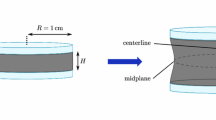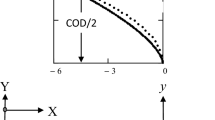Abstract
Through direct comparisons with experiments, Lefèvre et al. (Int. J. Frac. 192:1–23, 2015) have recently confirmed the prevailing belief that the nonlinear elastic properties of rubber play a significant role in the so-called phenomenon of cavitation—that is, the sudden growth of inherent defects in rubber into large enclosed cavities/cracks in response to external stimuli. These comparisons have also made it plain that cavitation in rubber is first and foremost a fracture process that may possibly depend, in addition to the nonlinear elastic properties of the rubber, on inertial effects and/or on the viscous dissipation innate to rubber. This is because the growth of defects into large cavities/cracks is locally in time an extremely fast process.
The purpose of this Note is to provide insight into the relevance of inertial and viscous dissipation effects on the onset of cavitation in rubber. To this end, leaving fracture properties aside, we consider the basic problem of the radially symmetric dynamic deformation of a spherical defect embedded at the center of a ball made up of an isotropic incompressible nonlinear viscoelastic solid that is subjected to external hydrostatic loading. Specifically, the defect is taken to be vacuous and the viscoelastic behavior of the solid is characterized by a fairly general class of constitutive relations given in terms of two thermodynamic potentials—namely, a free energy function describing the nonlinear elasticity of the solid and a dissipation potential describing its viscous dissipation—which has been shown to be capable to describe the mechanical response of a broad variety of rubbers over wide ranges of deformations and deformations rates. It is found that the onset of cavitation is not affected by inertial effects so long as the external loads are not applied at a high rate. On the other hand, even when the external loads are applied quasi-statically, viscous dissipation can greatly affect the critical values of the applied loads at which cavitation ensues.


Similar content being viewed by others
Notes
The focus of this Note is on homogeneous solids thus the choice of constant mass density \(\rho_{0}\).
As is the case in elastodynamics, accounting for a pressurized cavity would not pose any additional difficulty.
Throughout this work we consider isothermal conditions.
References
Ball, J.M.: Discontinuous equilibrium solutions and cavitation in nonlinear elasticity. Philos. Trans. R. Soc. A 306, 557–611 (1982)
Bergström, J.S., Boyce, M.C.: Constitutive modeling of the large strain time-dependent behavior of elastomers. J. Mech. Phys. Solids 46, 931–954 (1998)
Calderer, C.: Radial motions of viscoelastic shells. J. Differ. Equ. 63, 289–305 (1986)
Calderer, C.: Finite time blow-up and stability properties of materials with fading memory. Math. Methods Appl. Sci. 9, 13–34 (1987)
Chosky, R.: The singular limit of a hyperbolic system and the incompressible limit of solutions with shocks and singularities in nonlinear elasticity. Q. Appl. Math. 55, 485–504 (1997)
Chou-Wang, M.-S.O., Horgan, C.: Cavitation in nonlinear elastodynamics for neo-Hookean materials. Int. J. Eng. Sci. 27, 967–973 (1989)
Cohen, T., Molinari, A.: Dynamic cavitation and relaxation in incompressible nonlinear viscoelastic solids. Int. J. Solids Struct. 69–70, 544–552 (2015)
Coleman, B.D., Hill, E.H.: On the stability of certain motions of incompressible materials with memory. Arch. Ration. Mech. Anal. 30, 197–224 (1970)
Doi, M., Edwards, S.F.: The Theory of Polymer Dynamics. Oxford University Press, New York (1998)
Gent, A.N., Lindley, P.B.: Internal rupture of bonded rubber cylinders in tension. Proc. R. Soc. Lond. A 249, 195–205 (1959)
Gent, A.N., Park, B.: Failure processes in elastomers at or near a rigid inclusion. J. Mater. Sci. 19, 1947–1956 (1984)
Giesselmann, J., Tzavaras, A.E.: Singular limiting induced from continuum solutions and the problem of dynamic cavitation. Arch. Ration. Mech. Anal. 212, 241–281 (2014)
Green, A.E., Zerna, W.: Theoretical Elasticity. Oxford University Press, London (1954)
Guo, Z.-H., Solecki, R.: Free and forced finite amplitude oscillations of an elastic thick-walled hollow sphere made of incompressible material. Arch. Mech. Stosow. 15, 427–433 (1963)
Knowles, J.K., Jakub, M.T.: Finite dynamic deformations of an incompressible elastic medium containing a spherical cavity. Arch. Ration. Mech. Anal. 18, 367–378 (1965)
Kumar, A., Lopez-Pamies, O.: On the two-potential constitutive modelling of rubber viscoelastic materials. C. R., Méc. 344, 102–112 (2016)
Lawson, J.D.: An order five Runge–Kutta process with extended region of stability. SIAM J. Numer. Anal. 3, 593–597 (1966)
Lax, P.: Hyperbolic Systems of Conservation Laws and the Mathematical Theory of Shock Waves. CBMS Conference Series. SIAM, Philadelphia (1973)
Lefèvre, V., Ravi-Chandar, K., Lopez-Pamies, O.: Cavitation in rubber: an elastic instability or a fracture phenomenon? Int. J. Fract. 192, 1–23 (2015)
Le Tallec Rahier, C., Kaiss, A.: Three-dimensional incompressible viscoelasticity in large strains: formulation and numerical approximation. Comput. Methods Appl. Mech. Eng. 109, 233–258 (1993)
Lopez-Pamies, O.: A new \(I_{1}\)-based hyperelastic model for rubber elastic materials. C. R., Méc. 338, 3–11 (2010)
Lopez-Pamies, O., Idiart, M.I., Nakamura, T.: Cavitation in elastomeric solids: I—A defect-growth theory. J. Mech. Phys. Solids 59, 1464–1487 (2011)
Lopez-Pamies, O., Nakamura, T., Idiart, M.I.: Cavitation in elastomeric solids: II—Onset-of-cavitation surfaces for Neo-Hookean materials. J. Mech. Phys. Solids 59, 1488–1505 (2011)
Miroshnikov, A., Tzavaras, A.E.: On the construction and properties of weak solutions describing dynamic cavitation. J. Elast. 118, 141–185 (2015)
Ogden, R.W.: Non-linear Elastic Deformations. Dover, Mineola (1997)
Pericak-Spector, K.A., Spector, S.J.: Nonuniqueness for a hyperbolic system: cavitation in nonlinear elastodynamics. Arch. Ration. Mech. Anal. 101, 293–317 (1988)
Pericak-Spector, K.A., Spector, S.J.: Dynamic cavitation with shocks in nonlinear elasticity. Proc. R. Soc. Edinb., Sect. A, Math. 127, 837–857 (1997)
Ravi-Chandar, K.: Private communication (2016)
Reese, S., Govindjee, S.: A theory of finite viscoelasticity and numerical aspects. Int. J. Solids Struct. 35, 3455–3482 (1998)
Zhang, Y., Huang, Z.: Void growth and cavitation in nonlinear viscoelastic solids. Acta Mech. Sin. 19, 380–384 (2003)
Acknowledgements
This work was supported by the National Science Foundation through the Grant CMMI–1235352. D. A.-I. is also indebted to the Spanish Ministry of Economy and Competitiveness (Projects EUIN2015-62556 and DPI2014-57989-P) for the financial support received which allowed him to conduct part of this work.
Author information
Authors and Affiliations
Corresponding author
Rights and permissions
About this article
Cite this article
Kumar, A., Aranda-Iglesias, D. & Lopez-Pamies, O. Some Remarks on the Effects of Inertia and Viscous Dissipation in the Onset of Cavitation in Rubber. J Elast 126, 201–213 (2017). https://doi.org/10.1007/s10659-016-9589-y
Received:
Published:
Issue Date:
DOI: https://doi.org/10.1007/s10659-016-9589-y




